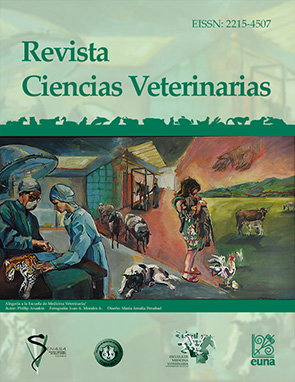Control of Varroa destructor mites in capped worker brood cells by using formic acid and thymol in africanized honey bee colonies under tropical conditions. A technical note
DOI:
https://doi.org/10.15359/rcv.34-2.3Keywords:
formic acid, thymol, Varroa destructor, Africanized honeybees, sealed brood cellsAbstract
The mortality of the Varroa destructor mite was evaluated in capped worker brood cells by using formic acid and thymol in Africanized honey bee colonies. The apiary was located in Atenas, Alajuela, Costa Rica, and was randomly arranged in three groups: A, B and C. Group A was treated with 150 g formic acid at 65%, while group B received two applications of 25 g thymol, and group C was used as a control group. Mortality of the Varroa’s different stages was evaluated in capped worker brood cells by checking the pupa and the bottom of the cell for mites. Eighty-six percent mite mortality occurred in capped brood cells in colonies treated with formic acid, while Varroa mortality was less than 10% in capped cells for control colonies and colonies treated with thymol. In conclusion, high mortality of Varroa mites was observed in capped brood cells after applying formic acid, while mortality was low in control colonies and colonies treated with thymol. The foregoing could imply a direct effect of formic acid over mites in capped brood cells.References
Adamczyk, S., Lázaro, R., Pérez-Arquillué, C., Conchello, P. & Herrera, A. 2005. Evaluation of residues of essential oil components in honey after different anti-Varroa treatments. J. Agric. Food Chem. 53: 10085-10090.
Baggio, A., Arculeo, P., Nanetti, A., Marinelli, E. & Mutinelli, F. 2004. Field trials with different thymol-based products for the control of Varroosis. Am. Bee J. 144: 395-400.
Bailey, L. 1984. Patología de las abejas. Acribia, Zaragoza, ES. 139 p.
Bailey, L. & Ball, B. 1991. Honey Bee Pathology. 2 ed. Academic Press, Londres, Reino Unido.193 p.
Bogdanov, S. 2006. Contaminants of bee products. Apidologie 37: 1-18.
Botta, E., Carmenate, H. & De la Torre, P. 2004. Varroasis peligrosa enfermedad de la abeja melífera. Fitosanidad 1: 73-79.
Calderón, R., Ortiz, R., Arce, H., Van Veen, J. & Quan, J. 2000. Effectiveness of formic acid on varroa mortality in capped brood cells of Africanized honey bees. J. Apic. Res. 39: 177-179.
Calderón, R., Fallas, N. & Sánchez, L. 2007. Detección de enfermedades en abejas Africanizadas en Costa Rica. Cien. Vet. 25: 335-348.
Calis, J., Boot, W., Beetsma, J., Van Den Eijnde, J., Ruijter, A. & Van Der Steen, J. 1998. Control of varroa combining trapping in honey bee worker brood with formic acid treatment of the capped brood outside the colony: putting knowledge on brood cell invasion into practice. J. Apic. Res. 37: 205-215.
Donzé, G. & Guerin, P. 1994. Behavioral attributes and parental care of varroa mites parasiting honey bee brood. Behav. Ecol. Sociobiol. 34: 305-319.
Eguaras, M., Labattaglia, M., Faverin, C., Del Hoyo, M., Palacio, M., Carrin, A., Ruffinengo, S. & Bedascarrabure, E. 2001. Varroa jacobsoni control with formic acid used in different application ways in subtropical and temperate climates. Apiacta 36: 97-101.
Eguaras, M., Palacio, M., Faverin, C., Basualdo, M., Del Hoyo, M., Velis, G. & Bedascarrasbure, E. 2003. Efficacy of formic acid in gel for varroa control in Apis mellifera L.: importance of the dispenser position inside the hive. Vet. Parasitol. 111: 241-245.
Espina, D. & Ordetx, G. 1984. Apicultura tropical. Tecnológica de Costa Rica, Cartago, CR. 506 p.
Gregorc, A. & Planinc, I. 2005. The control of Varroa destructor in honey bee colonies using the thymol-based acaricide- Apiguard. Am. Bee J. 145: 672-675.
Ifantidis, M. 1997. Ontogenesis of Varroa jacobsoni Oud. En Cahiers Options Méditerranéennes. Varroosis in the Mediterranean region. CIHEAM, Zaragosa, ES. p 13-21.
Koeniger, N. & Fuchs, S. 1988. Control of Varroa jacobsoni Oud. in honeybee colonies containing sealed brood cells. Apidologie 19: 117-130.
Martin, S. 1994. Ontogenesis of the mite Varroa jacobsoni Oud. in worker brood of the honeybee Apis mellifera L. under natural conditions. Exp. Appl Acarol. 18: 87-100.
Martin, S. 1995. Ontogenesis of the mite Varroa jacobsoni Oud. in drone brood of the honeybee Apis mellifera L. under natural conditions. Exp. Appl. Acarol. 19: 199-210.
Martin, S; Holland, K. & Murray, M. 1997. Non-reproduction in the honey bee mite Varroa jacobsoni in honey bee (Apis mellifera) colonies. J. Apic. Res. 36: 113-123.
Palmeri, V; Campolo, O. & Zappala, L. 2007. Evaluation of two methods for applying Apiguard® in an area with continuous nectar flows and brood rearing. J. Apic. Res. 46: 105-109.
Ritter, W. 2001. Enfermedades de las abejas. Acribia, Zaragoza, ES. 146 p.
Satta, A., Floris, I., Eguaras, M., Cabras, P., Garau, V. & Melis, M. 2005. Formic acid-based treatments for control of Varroa destructor in a mediterranean area. J. Econ. Entomol. 98: 267-273.
Van Alten, A., Tam, J. & Kempers, M. 2009. Winter colony health assessment after using Mite Away™ Quick Strip (MAQS™) as a control for varroa mites in the fall of 2009. Ontario Beekeepers association, CA. 5 p.
Vandame, R. 2000. Control alternativo de varroa en apicultura. El Colegio de la Frontera Sur (ECOSUR). Chiapas, MX. 30 p.
Downloads
Published
How to Cite
Issue
Section
License
Licensing of articles
All articles will be published under a license:

Licencia Creative Commons Atribución-NoComercial-SinDerivadas 3.0 Costa Rica.
Access to this journal is free of charge, only the article and the journal must be cited in full.
Intellectual property rights belong to the author. Once the article has been accepted for publication, the author assigns the reproduction rights to the Journal.
Ciencias Veterinarias Journal authorizes the printing of articles and photocopies for personal use. Also, the use for educational purposes is encouraged. Especially: institutions may create links to specific articles found in the journal's server in order to make up course packages, seminars or as instructional material.
The author may place a copy of the final version on his or her server, although it is recommended that a link be maintained to the journal's server where the original article is located.
Intellectual property violations are the responsibility of the author. The company or institution that provides access to the contents, either because it acts only as a transmitter of information (for example, Internet access providers) or because it offers public server services, is not responsible.







